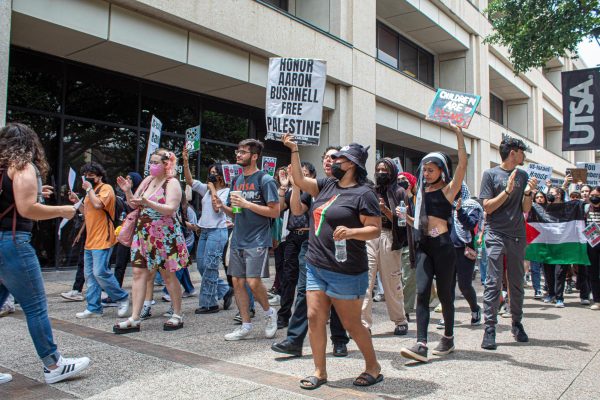Veteran and Military Affairs experiences staff shortage, affecting student-official ratio
April 12, 2022
The U.S. Department of Veteran Affairs (VA) recommends for every 200 students, there should be one certifying official to make accommodations and process benefits. At UTSA, there are five officials servicing approximately 5,000 students on federal benefits and approximately 4,000 on state benefits. The ratio between certifier to student is staggering with approximately one certifier for every 1,800 students.
A certifying official is a UTSA staff member who undergoes training with the VA to bridge the gap between the university and the federal government. Michael Logan, Senior Director for Military and Veteran Affairs, described what the certifier’s workload entails.
“They’ll take a student who has enrolled in classes and evaluate what they’re registered for. So they have to go into DegreeWorks and they have to look because the VA will only pay for classes that are on an approved degree plan,” Logan said. “After that, then they have to calculate tuition because we have to send the bill to the VA.”
Accurate tuition is crucial as any overcharge would be given to the student, not the institution.
“That could cause a problem for students who are relying on that VA money to pay their rent, buy their groceries,” Logan said. “And so we get that calculation wrong and that really has serious consequences if we aren’t accurate on that.”
After the reports and bills are sent to the VA, the money is reconciled and all accounts are zeroed out. Certifiers also coordinate with the Fiscal Services Office and Registrar to ensure protection during the time it takes the VA to process benefits.
Despite the lack of certifying officials, Logan still mentioned the situation has allowed the department to be innovative, constantly in a state of important improvement.
“We grew during the pandemic. I think we were one of the top two or three institutions of the state that actually grew when everyone else was shrinking, but our number of certifying officials has stayed static for about 10 years,” Logan said. “So as the enrollment has gone up, the staffing has stayed the same. Like I said, that’s what’s really driven us to have to be innovative and have to be lean.”
“And you’ll hear me say in one breath you know we’re under-resourced, we’re understaffed and think of all the speed and accuracy we can gain by getting more human resources. At the next breath, you’ll hear me say that having to be in that situation has really enabled us to implement a lot of innovative strategies that have actually made us a leader in what we do in the state of Texas.”
Logan shed light on how the university has responded when it comes to giving aid and resources to the department. He stated that even though the university hasn’t given funds to hire more full-time employees, there have been efforts in other areas.
“You can say I’m that squeaky wheel. I’m the one who, when you invite me to the meeting somewhere in that meeting, I’m going to ask the question about resources,” Logan said. “So the response from UTSA. We haven’t been ignored. I can tell you that. I can tell you that because of what I mentioned earlier, the access that I have to leadership means that not only can I talk to them, but that we can communicate more freely about the situation context. And so even though there hasn’t necessarily been an increase in permanent funding so that I can hire more full-time folks, accommodations have been made wherever possible.”
“I can say that we usually get first consideration and so we’ve been able to expand by creatively using one-time funds using reimbursement funds that we get as a VA reimburses us for, because of the services that we provide certifying students for them,” Logan continued.
He also mentioned that even though the university works with the department, it doesn’t always keep pace and doesn’t get them to the 200-1 ratio recommended by the VA.
“It shows that management is aware. They’re hearing what we’re saying and they’re doing what they can to find us the resources where they exist,” Logan continued.
To supplement the areas where the university couldn’t fill in, Logan takes on his own efforts at development and fundraising.
“We do that with the aim of being able to create part-time and full-time positions that ideally we can recruit either undergraduate or graduate students in these temporary roles using some of those temporary funding,” Logan said.
“The unintended benefit of doing that was we might bring in a graduate student on a temporary basis because we had one one-time funding for it. Then, all of a sudden we find ourselves in a position where maybe one of our certifying officials is leaving the university going on to different things, but now we’ve already cultivated a replacement,” Logan continued. “Now we have someone who’s fully trained up so we’re not losing a year of productivity because the university helps us by finding these one-time funds and kind of allowing us to cultivate future full-time employees, we’ve really avoided pinch points with high turnover. So that’s a plus.”
When it comes to finding a solution to the disproportionate amount of certifiers for students, Logan pointed to several areas.
“It begins with a given college, understanding and consolidating its operations because, prior to 2018 [when the department consolidated], I don’t think there was a very good volume of work that went in supporting militarily because it was so spread out different chains of commands. It’s honoring those pieces of the picture,” Logan said.
“So I think step one would be kind of doing what we did here at UTSA and just basically take stock of everything that’s going on in one place so that we really understand what your population needs and what you need to deliver to them so they can be successful,” Logan continued. “Step two is articulating to leadership what the needs are, and that includes exhausting, I believe all avenues of operation as lean as it possibly can. Then there’s looking at how can you more effectively divide up the workload. So if you have a population as big as ours, what are some efficient ways that work can be conducted.”
“And then finally, it also has to do with staying engaged. The VA does give us a reimbursement stipend, so typically about $50,000 to $60,000 a year and we use that to reinvest that into paying a full-time staff member to essentially oversee our customer service operation. So there’s places where maybe those funds are being used for other things like programming,” Logan said. “So what we do is we try to use that in a way that we know that we could raise money for because when you see donations, it’s usually for a project maybe for scholarships, maybe it’s the – you know – help underserved students or maybe to bridge tuition gaps that happened after someone runs out of GI Bill. Usually, when you’re raising funds that way, it’s for something specific that puts money in the hands of students. So we have to be very smart about using the resources that we have.”












